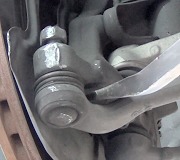Start by running it in gear with the front wheels jacked up and the car supported on jack stands. Watch the spinning tire from the front to see if there's any sideways movement in the tread or a noticeable hump on one side of the tread. A little movement is normal but if you see more than about 1/8", that's cause to look closer.
Next look at the edge of the wheel where the weights go. 1/8" there is way too much. Typically only one wheel will be spinning. You have to carefully stop it to make the other one start spinning. I do that by wedging a 2x4 under the spinning tire but be careful because if it's laying close to the ground the tire can shoot it out if it's spinning fast enough.
You can also identify a tire or wheel problem by switching them front-to-rear, then see if the characteristics of the vibration are the same.
If you see one wheel wobble, pull that one off, then run it in gear again and watch the brake caliper. If it's moving side-to-side, even a little, your new rotor is warped or there is something stuck between it and the hub. Both of those are common. A cut on the brake lathe will true up the rotor. Usually once they're machined they typically don't warp again.
A hard-to-find cause of a shimmy in the steering wheel is a worn inner cv joint housing. I won't describe that now because it's pretty involved to check and it almost always shows up only during acceleration
Tuesday, October 9th, 2012 AT 12:28 AM



